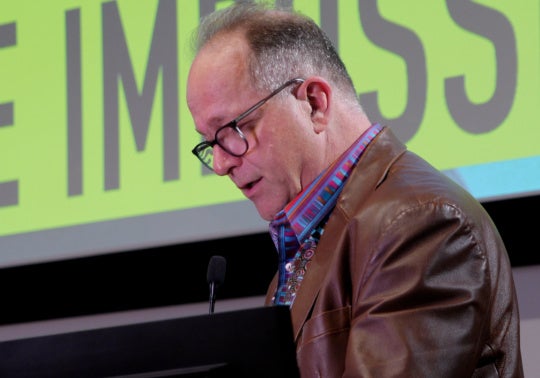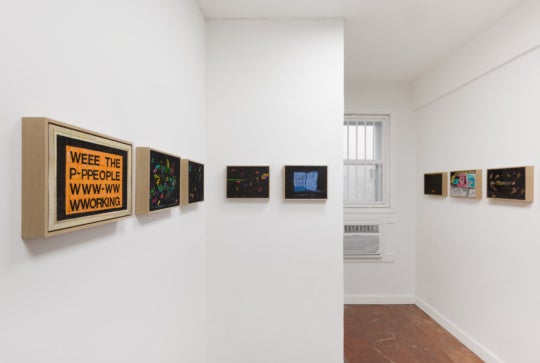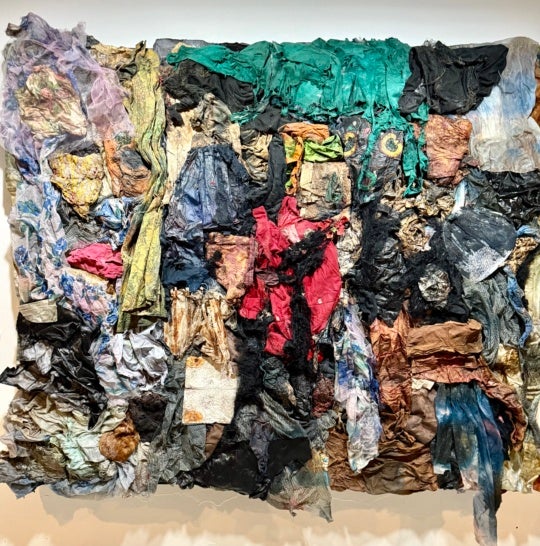Memphis-based artist Greely Myatt made time while installing his current exhibition, Nice Once, at the Swan Coach House Gallery (which runs through September 29) to talk about himself and his work. In 2009 Myatt enjoyed a celebration of his two-decade career as 10 venues in Memphis showed his art. A catalog, Greely Myatt and exactly Twenty Years, documents some of his often wry sculptures, assemblages, and installations. He is the recipient of fellowships from the Tennessee Arts Commission; of a grant from Alternate Roots; and of awards from the Mississippi Institute of Arts and Letters and from the University of Memphis, where he has been a full professor of art since 1999.

Greely “was my father’s middle name [and] my grandfather’s first name,” the artist said a few days before the opening in Atlanta. Consider the women in his family tree in any search for what underlies his artistic practice, however: “I have a twin sister and an older sister. My father passed when I was only 10 months old and my mother never remarried. … [O]nly women [surrounded] me while [I was] growing up. My twin … sewed a bit …. Both my grandmothers had quilted …. [M]y mother’s mother was probably the biggest influence on the quilts.”
Myatt’s own “quilts” include no cloth. Instead, the panels that constitute his downtown Memphis installation Quiltsurround (2009), for example, are metal. As with the waste-not-want-not ethos of textile quilting, however, he employs “spent” materials in such sculptures: “I decided to recycle [traffic] signs from the city,” he said, referring to ones damaged in car crashes, storms, and the like. Using a miter saw and a band saw, he cuts the sheet aluminum, “same as wood,” into such familiar quilt shapes as sunbursts and windmills. Another Nice One, a Sandler Hudson Gallery exhibition (September 14–October 20) roughly simultaneous to the one at Swan Coach House Gallery, puts several rather quilty Myatts on the gallery roof.

A less literal form of recycling is at play in Myatt’s Swan Coach House work, most of which borrows from the iconography of the comics medium. Specifically, sculptures including Page (Hagar) (2011) reproduce/recast frames from such stalwart newspaper strips as Garfield and Hagar the Horrible. Myatt sometimes strips away all pictorial elements to leave only the rectangular picture frames and the often (but not always) ovoid dialogue frames. Thus, these works become frames for an exchange (or series of exchanges) that viewers must imagine. “I read two things in the [news]paper,” the artist says: “Comics and letters to the editor.” Imagining his sculpture as melding those two wildly different modes—the humor of the former and the dialectics of the latter—might be close to what Myatt has in mind.
The Mississippi native’s approach to the stuff of comics has evolved, however. One 2006 work began with Myatt “clipping out [newspaper comics] frames” and collaging them into “a big grid of these things” on a canvas. He whited out everything but dialogue, some of it internal. The wording in one such excerpted thought balloon was “I gotta learn how to talk,” which became the assemblage’s title. In subsequent works, Myatt says, “At some point I got rid of the canvas and did just the steel.” Of course, the original dialogue went away as well.
Another 2011 Myatt sculpture, Volume II, evokes comic books (instead of strips) with its upright wedge-shaped footprint surrounding conjoined frames that suggest pages. Its innards are the steel outlines of word balloons whose proximity to one another makes them the visual equivalent of overlapping speech, overlapping narratives: the welter that is human interaction, perhaps? “To make nonreferential work is hard for me,” Myatt says. The lifelong Southerner, referring to a body of literature worlds away from that of the comics, notes that he “came out of a narrative tradition. The greatest writers in the world were Southern.”
Ironically in the classrooms of Myatt’s 1970s higher education, “teachers … left us with the impression that comics, or [things] from popular culture, weren’t high-minded enough.” One exception: sculptor Floyd Shaman, who introduced Myatt to H.C. Westermann’s work. Nowadays, of course, Myatt is the instructor, teaching sculpture to University of Memphis students. He shows them the work of Chicago’s Hairy Who artists (with whom Westermann, a satirical printmaker and sculptor, is sometimes linked) and points them toward comics “as a point of departure, just like anything can be.”
And in terms of such departures, Myatt himself has come full circle (or perhaps full oval), in a sense: While executing a recent series of works that use wood-burner tools to transfer the outlines of comics frames and balloons onto wood panels, he created a few that inadvertently fused the original paper dialogue bubble to the surface at hand. He decided that he liked the effect. Although these smaller pieces are not on display in Nice One, they can be seen at the Swan Coach House Gallery upon request.
Greely Myatt is slated to attend a reception at the Swan Coach House Gallery 6–9PM Thursday, September 13; he delivers an artist talk there 11AM Saturday, September 15.
Myatt is to attend a reception at Sandler Hudson Gallery 7–9PM Friday, September 14.




